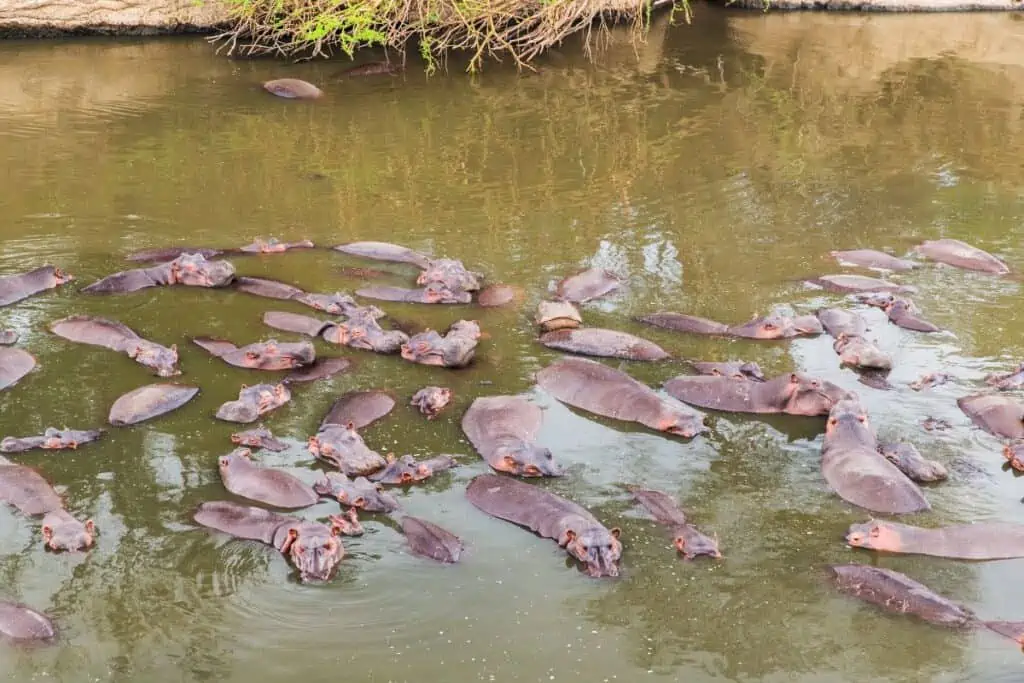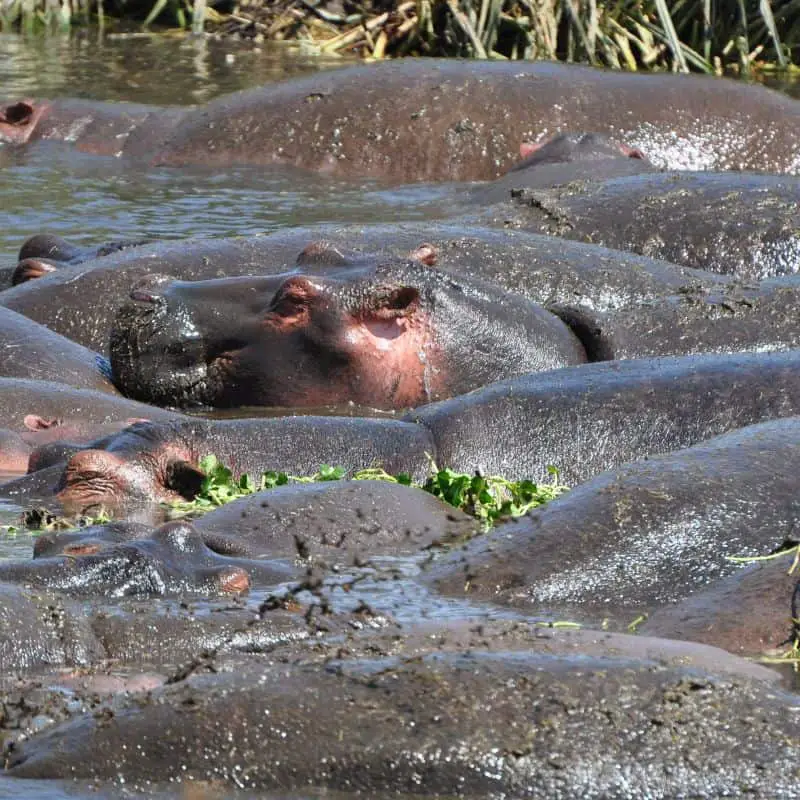Hippos are rarely seen alone, so when you see many of them together, how do you describe the scene? Just what is a group of hippos called?
Hippos are social animals, living in groups of ten to thirty called bloats. Bloat has males, females, and calves led by a dominant male who is the commander and can mate with any female of the bloat. Those in a bloat collectively enjoy a more secure life under the rule of the dominant male Hippo.
This article will dive into the fascinating world of hippo social groups, including their hierarchical dominance systems.

Do Hippos Live in Groups?
Although they are nocturnal, hippos love spending their lives together. They even gather when submerged; they’re rarely alone, almost always in a group.
The hippopotamus often lives in groups of ten to thirty other hippos. They have even congregated in larger herds of up to two hundred animals.
What Is a Group of Hippos Called?
Generally, a group of hippos is called a bloat. The other names for hippo groups include:
- Herd
- Pod
- School
Although there are no definitive criteria to assign either group name, a congregation of 10-15 individuals is usually called a herd or pod.
In comparison, 40 individuals are grouped as a school.
Where the Group Name “Bloat” Came From?
The term used to describe a group of animals is usually based on one or more physical or behavioral characteristics.
For example, pride, the word for a group of lions, is related to their ferociousness and strength, zebras are called zeal because of their stripes, and giraffes are called a tower because they’re tall.
The term used for a group of animals relates to the animals in question and provides fun wordplay that makes them memorable.
A bloat of hippos is a term from 1939 that refers to their large, distended bellies. This bloating is usually structural and caused by their diet of almost exclusively grass, which they can store in their stomachs for up to three weeks.

What Does a Bloat of Hippos Consist Of?
The bloat has several adult females and several adult males as well as calves, but there is one dominant male.
This male usually mates with all the adults in his herd and rarely allows his subordinate males to mate.
To ensure everyone knows who the boss is, he spreads his dung everywhere with his fan-shaped tail.
How Does a Male Assert Its Dominance?
Young hippos do not attempt to establish dominance over others in their group until they reach the age of seven.
Power is typically displayed through yawning, roaring, spraying dung, and clashing jaws. Dominant males often become aggressive when their authority is questioned.
Upon encountering another male hippopotamus, two males will position themselves nose-to-nose with their mouths agape at a 180-degree angle.
It is called “gaping” and functions to size each other up. In most cases, the smaller male retreats without being pursued by the larger one.
If two hippos fight, they will use their tusks (massive teeth) to slash at each other or swing their heads around like sledgehammers.
These battles can result in the losing hippopotamus losing more than just its dignity.
Benefits Of Group Life For Hippos
Since hippos are such colossal giants in the wild, it’s no surprise they’re often seen as prey by hyenas, lions, and crocodiles.
Since they share the same waters with crocs, they need to stay in groups so these powerful reptiles don’t drag off younger lone hippos.
In the event of an attack, the dominant male leads from the front and fights off intruders with his gigantic tusks. Other males bellow together to scare off opponents and protect the bloat.
Though they may be herbivorous, hippos are still incredibly powerful.
Their large size gives them immense strength, and they can become aggressive quickly.
Though their mouths and teeth allow them to protect themselves against moderate carnivores (and even humans), it can be challenging for them alone against groups of larger predators.
Living in groups is often much more secure for them.
Final Thoughts on Hippos Groups
Hippos have hierarchical societies with a dominant male leading the group, but they also display strong bonds within their family units.
They engage in various social activities such as vocal communication, feeding, and displays of aggression or dominance and defense.
When hippos live in groups, called a bloat, they have better living conditions than those that live alone.

FAQs
Do Hippos Work Together?
Hippos often engage in activities together, such as leaving their water habitat at night to search for food. A group of ten to thirty hippos usually live together, with the dominant male leading the pack. Though the dominant male has exclusive rights when choosing a mating partner, the group feeds and defends itself collectively.
Are Hippos Social Animals?
Though nocturnal, hippos are highly social animals and often travel in groups of ten to thirty, called a bloat. Together, the bloat completes daily routines such as feeding, moving around, and fending off intruders.
Why Do Hippos Bite Each Other?
Like many animals in the wild, fighting is often how they settle disputes. When a dominant male hippo feels that his authority or territory is threatened, he will fight with the new contender.
What Is a Group of Female Hippos Called?
Female hippos do not live by themselves; they group together. Females need males for things other than just mating, such as defense against predators when their calves are present. This cooperative group of females and males is called a bloat.
